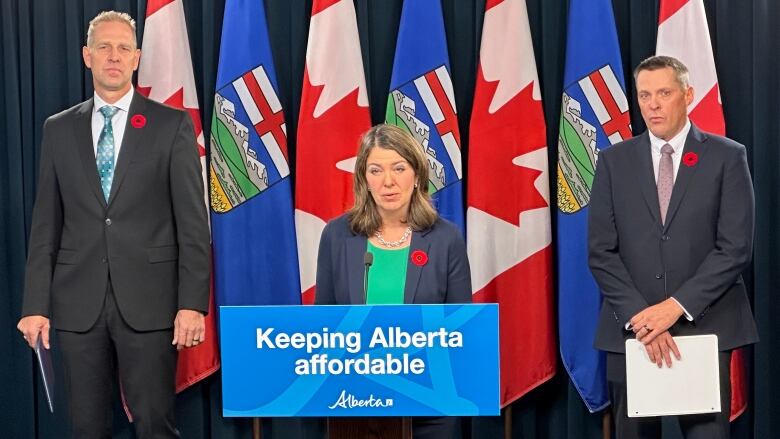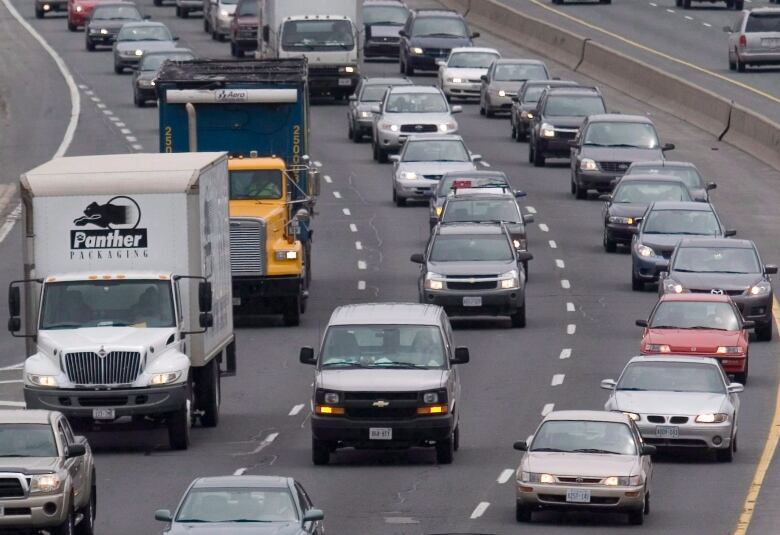Alberta announces limit on auto insurance hikes for 'good drivers'
Government also exploring reform for auto insurance system in the long-term

The Alberta government will limit auto insurance premium hikes to the rate of inflation for motorists they deem to be "good drivers."
It's a distinction the Opposition says is too narrow, and could lead to price jumps for many Albertans.
Premier Danielle Smith announced the measure at the legislature on Wednesday, flanked by Finance Minister Nate Horner and Affordability and Utilities Minister Nathan Neudorf.
In a change of tone for the UCP government, Horner now also says he's keeping an open mind to a no-fault system of insurance and possibly creating a public insurance Crown corporation like in Saskatchewan and British Columbia.
The rate hike limit will be a short-term measure, Horner said, while actuarial consultant Oliver Wyman completes a $500,000 review and study of other jurisdictions. The consultant's report is due to government in the first quarter of 2024.
"This is not sustainable either," Horner said of the new premium cap, set to take effect in January 2024. "Nothing in this package really gets at the cost associated to auto insurance."
The newreview comes in the wake of a 2019 review, also conducted by a UCP government-appointed panel, that produced a 536-page report outlining 37insurance reform recommendations. Among them was the adoption of no-fault insurance.
Alberta drivers pay some of the highest insurance premiums in the country.

The incoming limit on drivers' rate increases would be tied to the consumer price index, as measured in September of the previous calendar year. That means in 2024, drivers who stick with the same insurance company could not see their premiums rise by more than 3.7 per cent, according to the province.
A "bad" driver would not be protected from such rate hikes, and include those who:
- Had one or more at-fault crashes in the last six years.
- Had a criminal code traffic conviction during the last four years, such as impaired driving.
- Had a major traffic conviction during the last three years, including distracted driving or speeding in a school zone.
- Had a minor traffic conviction in the last three years, such as failure to stop or following too close.
The province estimates the majority of Alberta drivers would be considered good drivers under the new definitions, but did not have hard numbers.
However, the measures wouldn't help new drivers or people who switch to a different insurance company for coverage.
The Alberta NDP slammed the measure, saying the definition of a "good driver" is too narrow. Opposition house leader Christina Gray said it could also punish consumers who switch insurance providers.
"If you got two traffic tickets in the last three years, buckle up your rates are going to soar," Gray said.
More power for regulator
The government is also giving the Automobile Insurance Rate Board (AIRB) new powers to demand insurance companies return some profits to drivers during "exceptionally profitable years."
The AIRB would develop a policy on how to return any excess profits to consumers.
Regulations require insurance companies to limit their profits to six per cent of total premiums charged in Alberta.
Injury lawyer Nainesh Kotak, who practices in Ontario and Alberta, says the government should codify that limit into law. He says the AIRB should consider all of insurers' profits when making this calculation, including investment income.
Insurers should be allowed a profit, he said, but to a limit, because auto insurance is mandatory to drive a vehicle.
Kotak said the AIRB should have firm rules on pulling back excess profits, rather than subjective discretion.
The province also plans to make permanent a requirement for companies to provide most customers with payment plans so they don't have to fork over a chunk of cash once a year.
The future of insurance
Although Horner and his predecessor, Travis Toews, previously dismissed suggestions of a no-fault insurance system or a provincial Crown corporation offering auto insurance, Horner said he's now keeping an open mind to both.
If these changes could help control the cost of premiums, they are worthy of consideration, Horner said.
These musings were met with pushback from both the insurance industry and lawyers who represent crash victims.
Grande Prairie lawyer Owen Lewis, chair of the Alberta Civil Trial Lawyers Association, said no-fault insurance may temporarily lower premiums. However, when injured people can't sue the drivers who were responsible, limits on coverage can lead to reliance on public health and social service systems if the victim needs more rehabilitation or cannot work, he said.
Lawyer Kotak said in Ontario, the mixed system has led to hurdles for victims seeking compensation in court, denied coverage claims, and insurance premiums that are still too expensive.
Aaron Sutherland, vice-president of the Insurance Bureau of Canada, said introducing a public insurer could increase bureaucracy and decrease efficiency for people filing insurance claims.
The rate caps tried in Alberta and elsewhere do not control premium costs in the long term, he said.
Alberta requires insurance companies to sell "one-size-fits-all" policies that are too limiting, he said. If insurance sellers could offer more choices of coverage, customers could have more control over their premiums, he said.
With files from Marc-Antoine LeBlanc












_(720p).jpg)


 OFFICIAL HD MUSIC VIDEO.jpg)
.jpg)



























































































